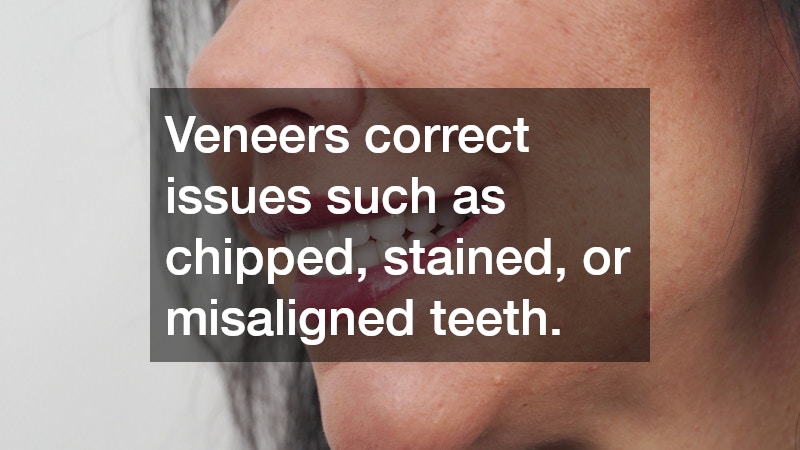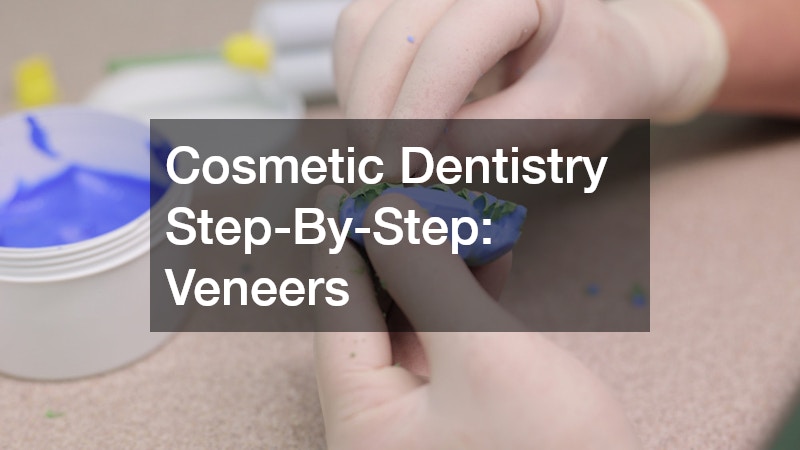
Cosmetic Dentistry Step-By-Step: Veneers
Exploring the transformative world of veneers in cosmetic dentistry, this article breaks down the steps, benefits, and considerations involved in opting for this popular dental procedure. Veneers have increasingly become a sought-after solution for those looking to achieve a perfect smile effortlessly. As a versatile treatment, they address various dental imperfections from discoloration to misalignment.
This article will guide you through every aspect of veneers, helping you weigh the pros and cons before making this significant decision. Understanding veneers’ nuances can substantially impact one’s confidence and oral health, deepening the appreciation for these small yet mighty dental transformations.
What are Dental Veneers?
Definition and Purpose
Veneers are thin shells designed to cover the front surface of teeth, dramatically improving their appearance. Crafted from porcelain or composite resin, they are bonded to the teeth for a durable, natural look. Primarily used in cosmetic dentistry, veneers correct issues such as chipped, stained, or misaligned teeth. Their primary purpose is aesthetic enhancement, making them a favorite among individuals seeking a brighter, more uniform smile. Beyond aesthetics, veneers can also provide a protective layer, potentially prolonging the lifespan of underlying teeth.
Types of Veneers
Two primary materials are used in veneer construction: porcelain and composite. Porcelain veneers are known for their durability and resistance to staining, offering a long-lasting solution with a natural appearance. On the other hand, composite veneers are more affordable but may not last as long, requiring more maintenance over the years. Each type of veneer material carries distinct characteristics, influencing their function and longevity. The choice between porcelain and composite often depends on personal preferences, budget, and specific dental needs.
Advantages of Veneers
Veneers provide numerous benefits that contribute to their widespread popularity. They effectively conceal dental imperfections, resulting in a harmonious and appealing smile. The process is relatively quick, with significant improvements seen in just a few visits to the dentist. Importantly, veneers offer a customizable approach, as each set is tailored to match the individual’s natural teeth, ensuring a seamless blend. Besides aesthetics, veneers add a protective barrier, which can help preserve teeth from further damage.
Disadvantages and Considerations
While veneers offer numerous benefits, there are also some considerations to keep in mind. The procedure is generally irreversible due to the enamel removal required for application. Some individuals may experience increased tooth sensitivity following the procedure. Veneers can be costly, especially those made from high-quality porcelain. Lastly, maintenance is key to their longevity, as certain habits like teeth grinding can shorten their lifespan, leading to potential replacements sooner than expected.
How Are Veneers Applied?
Initial Consultation
The journey to acquiring veneers starts with an initial consultation with a cosmetic dentist. During this session, the dentist assesses oral health, discusses aesthetic goals, and explains the veneer process in detail. It’s an opportunity for patients to express concerns and ask questions, ensuring clarity about the procedure’s scope. The dentist might use digital imaging or physical models to demonstrate potential outcomes, helping patients visualize the end results. This foundational meeting sets the tone for the subsequent phases, ensuring a personalized, well-informed approach.
Preparation of Teeth
Preparation is a critical step in fitting veneers, involving slight modifications to the teeth. A small portion of enamel—sometimes less than 0.5 millimeters—is removed to make room for the veneers, ensuring they sit flush and natural. This process might involve local anesthesia to minimize discomfort, though it’s generally painless. Enamel removal is necessary to prevent the veneers from appearing bulky or unnatural. Once prepared, teeth are ready for impressions, the next stage in the veneer application process.
Taking Impressions
Creating a mold of the teeth is essential for crafting custom veneers that fit precisely. During this step, the dentist takes impressions by having the patient bite into a soft putty-like material, capturing detailed contours of the teeth. These molds, along with chosen veneer color, are sent to a dental lab where specialist technicians design the veneers. This ensures that each veneer perfectly matches the individual’s natural tooth structure in size, shape, and color. The accuracy of these impressions directly impacts the fit and comfort of the final veneers.
Choosing the Right Shade
Selecting the appropriate shade for veneers is crucial to achieving a natural and aesthetically pleasing smile. Dentists often use shade guides to assist patients in choosing a color that blends seamlessly with existing teeth. Professional judgment combined with patient preference guides this decision, balancing between too white and too dull. The right shade can significantly enhance a person’s overall appearance, reflecting light in a manner similar to natural enamel. An optimally matched veneer color ultimately complements the entire facial structure, enhancing both confidence and smiles.
Fitting and Bonding
The final step involves fitting and securely bonding the veneers to the prepared teeth. The dentist will first temporarily place the veneers to check for fit, making any necessary adjustments to achieve optimal alignment and comfort. Once the fit is confirmed, the surfaces of the teeth are etched, creating a rough texture that facilitates strong bonding. A special adhesive is then used to affix the veneers permanently, ensuring they adhere firmly without gaps. This meticulous process requires precision, as it determines the stability and longevity of the veneers.
How Long Do Veneers Last?
Average Lifespan of Veneers
With proper care, veneers can last anywhere from 10 to 15 years or even longer. Longevity primarily depends on the material used, with porcelain generally outlasting composite veneers due to its superior durability. Additionally, personal habits and oral hygiene significantly influence how long veneers remain in top condition. While they come with an impressive lifespan, veneers aren’t permanent and will eventually need replacement. Investing in their maintenance is essential to maximize their functional life and aesthetic appeal.
Factors Affecting Longevity
Several factors can affect how long veneers last, ranging from material choice to individual behaviors. Habits such as teeth grinding or using teeth to open packages can cause damage, necessitating earlier replacement. Consuming hard foods and beverages that stain can also affect veneer appearance over time. Personal oral hygiene practices, like regular brushing and flossing, play a crucial role in maintaining the veneers’ integrity. Regular dental check-ups ensure potential issues are spotted early, averting significant damage.
Maintenance Tips
Preserving veneers requires daily care and routine dental visits. Patients should brush and floss regularly, using gentle, non-abrasive products to avoid scratching the veneer surface. Avoiding stain-causing substances like coffee, tobacco, and red wine can help maintain the veneers’ fresh appearance. Using a night guard can safeguard against grinding during sleep, potentially extending veneer lifespan. Routine dental check-ups complement at-home care, helping identify and resolve issues promptly.
How Much Do Veneers Cost?
Average Cost Breakdown
The cost of veneers varies, typically ranging between $800 to $2,500 per tooth, depending on the material and complexity. Porcelain veneers are generally more expensive than composite, due to their superior quality and longevity. Prices reflect comprehensive factors, including dentist expertise, geographical location, and preparatory work required. While initially expensive, veneers often prove to be a worthwhile investment for their transformative effects on one’s smile. Understanding the involved costs helps manage expectations and plan accordingly.
Insurance and Financing Options
Veneers are often considered cosmetic, meaning insurance coverage is typically limited. However, certain cases where veneers address functional issues may receive partial coverage. For many, financing options, such as payment plans and dental loans, help manage the financial burden. Patients are encouraged to discuss potential coverage and financing solutions with their dental provider. Exploring these options can make obtaining veneers a more accessible goal, spreading costs over time.
Cost vs. Benefits
Despite the expense, veneers offer considerable benefits that often outweigh the costs. Patients benefit from an immediate, noticeable improvement in smile aesthetics, boosting confidence and self-esteem. The durability and aesthetic enhancement provided by veneers make them a valuable long-term investment for many. Functionally, they can also provide additional tooth protection, potentially reducing future dental costs. Each individual’s evaluation of cost versus benefit is unique, influenced by personal priorities and financial circumstances.
The transformative power of veneers in cosmetic dentistry is undeniable, providing a pathway to a stunning, flawless smile. As explored, veneers offer substantial aesthetic benefits and non-negligible protective qualities, enhancing both appearance and dental health. However, their application involves numerous considerations, from material selection to maintenance commitment. Weighing these factors thoughtfully against personal goals and circumstances is crucial when deciding on veneers. Making an informed decision ensures that veneers’ aesthetic allure aligns with one’s long-term dental aspirations.


